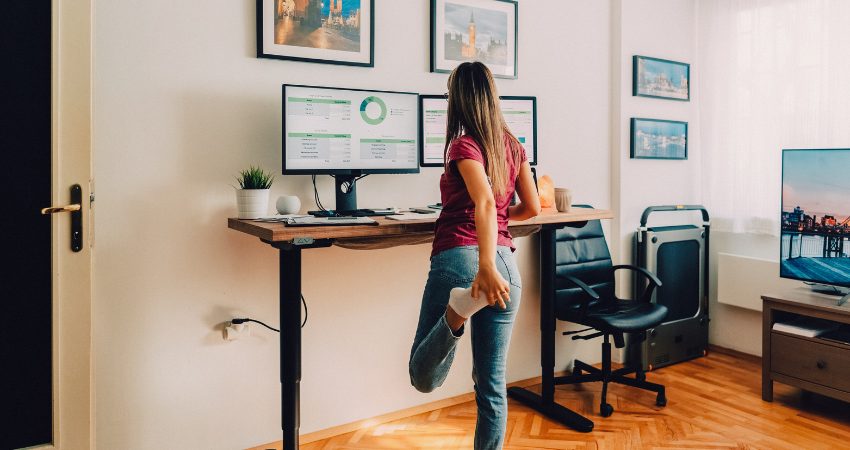Essentials for Creating an Ergonomic Workstation
Setting up an ergonomic workstation is essential for maintaining comfort, productivity and overall wellbeing while working. Here’s a comprehensive guide on the key considerations and items to include, along with the benefits of each ergonomic element.
- Adjustable Chair
An ergonomic chair is crucial for supporting your lower back, promoting good posture, and reducing strain.
Benefits:
- Lumbar Support: Reduces lower back pain by maintaining the natural curve of the spine.
- Adjustability: Allows for customisation of seat height, depth, and backrest recline to fit individual needs.
- Armrests: Adjustable armrests reduce strain on shoulders and arms.
- Sit/Stand Desk
Switching between sitting and standing throughout the day can significantly improve your health and productivity.
Benefits:
- Reduces Back Pain: Alternating between sitting and standing can help alleviate back pain and prevent musculoskeletal disorders.
- Improves Circulation: Standing periodically can improve blood flow and reduce the risk of cardiovascular issues.
- Boosts Energy and Mood: Changing positions can increase energy levels and improve mood and focus.
Positioning your monitor at eye level is essential to prevent neck strain and maintain good posture.
Benefits:
- Eye Level Positioning: Reduces neck and eye strain by keeping the monitor at a comfortable height.
- Flexibility: Adjustable stands and arms allow you to position the monitor for optimal viewing angles.
- Desk Space: Elevating the monitor frees up valuable desk space for other items.
- Monitor Riser
A monitor riser elevates your screen to eye level, reducing neck and shoulder strain.
Benefits:
- Improved Posture: Ensures your monitor is at the correct height, promoting better posture.
- Increased Desk Space: Provides additional storage space underneath for books, notebooks, or other items.
- Reduced Neck Strain: Keeps your neck in a neutral position, reducing the risk of strain and discomfort.
- Ergonomic Keyboard
Using an ergonomic keyboard can minimise strain and prevent repetitive stress injuries.
Benefits:
- Natural Hand Position: Split and curved designs help keep your hands in a more natural position, reducing strain.
- Wrist Support: Integrated wrist rests reduce pressure on the wrists during typing.
- Compact Design: Reduces the distance you need to reach for the mouse, minimising shoulder and arm strain.
- Ergonomic Mouse
An ergonomic mouse is designed to reduce wrist and hand strain, which is common with prolonged computer use.
Benefits:
- Vertical Design: Encourages a more natural hand position, reducing wrist strain.
- Adjustable Sensitivity: Allows for smoother and more precise cursor control, reducing repetitive movements.
- Comfortable Grip: Ergonomic shapes and sizes fit the hand better, reducing fatigue.
Keeping documents at an optimal viewing angle helps reduce neck movement and strain.
Benefits:
- Reduces Neck Strain: Keeps documents at eye level, reducing the need to bend or twist your neck.
- Improves Workflow: Having documents in line with your monitor can improve efficiency and comfort.
- Foot Rest
A foot rest can improve circulation and reduce strain on your lower back and legs.
Benefits:
- Improves Posture: Encourages proper alignment of the spine and reduces pressure on the lower back.
- Reduces Leg Strain: Provides support for the feet, reducing pressure on the legs and improving circulation.
- Adjustability: Allows for customisation to fit individual height and comfort preferences.
Summary of Ergonomic Essentials:
By incorporating these ergonomic elements into your workstation and adhering to recommended positioning guidelines for your monitor and keyboard (see below), you can create a healthier, more comfortable, and productive work environment.
- Adjustable Chair: Supports lower back and reduces strain
- Sit/Stand Desk: Enhances health by alternating sitting and standing
- Monitor Stand/Arm: Positions monitor at eye level to prevent neck strain
- Monitor Riser: Elevates screen to improve posture
- Ergonomic Keyboard: Reduces wrist strain with natural hand positioning
- Ergonomic Mouse: Minimizes wrist and hand strain
- Document Holder: Keeps documents at eye level
- Foot Rest: Improves posture and circulation
What is the Optimal Monitor and Keyboard Position?
Monitor Position
Your eyeline should be level with the top third of your monitor screen. The monitor should be about an arm’s length away from you, roughly 20-30 inches. This positioning helps reduce neck strain and ensures a comfortable viewing angle without excessive head movement.
Keyboard Position
Your keyboard should be positioned directly in front of you, and close enough to allow your elbows to remain at a 90-degree angle and your wrists to stay straight while typing. This setup minimises strain on your arms and wrists, promoting a more natural and comfortable typing posture.
By incorporating these ergonomic elements into your workstation and adhering to recommended positioning guidelines for your monitor and keyboard, you can create a healthier, more comfortable, and productive work environment.
For further support or advice, get in touch here with one of our friendly advisers at Quills Office Supplies for all your workplace essentials.










